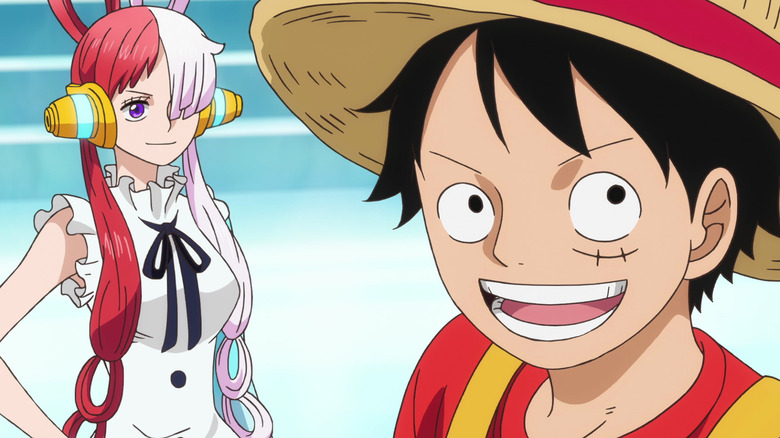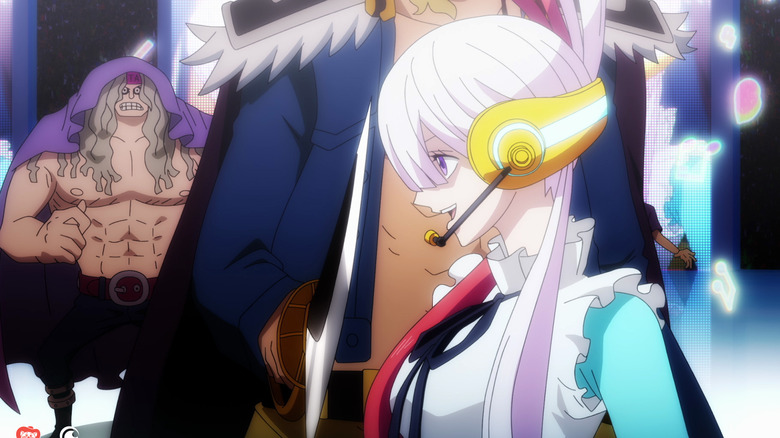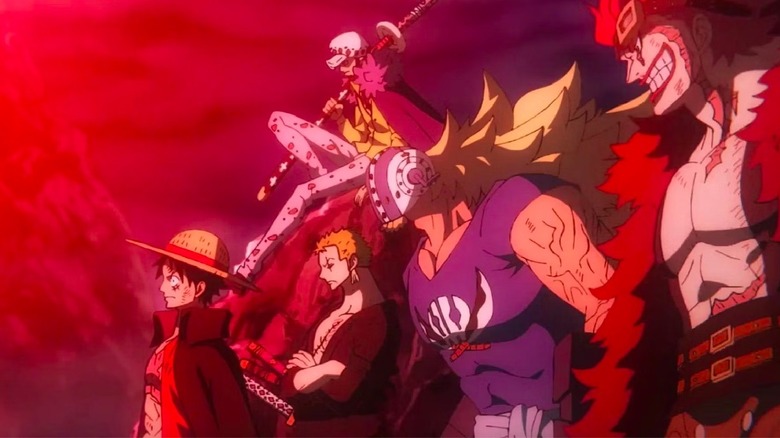One Piece Film: Red Review: Chaotic, Colorful, And A Pitchy But Fun Gateway For A One Piece Newbie
Why is "One Piece" one of the longest-running animes ever? What's so special about this goofy series about a young boy with the ability to turn his body into rubber, whose dreams of becoming the Pirate King have persisted for nearly 25 years? For a long time, that answer has escaped me, even as I recognized its impact and saw whole stores and statues dedicated to the beloved anime while visiting Japan, or caught a handful of episodes on Cartoon Network. But with "One Piece Film: Red," I kind of get it.
The "One Piece" feature film directed by Gorō Taniguchi and written by Tsutomu Kuroiwa is a one-off adventure unrelated to the events of the main series, but it manages to capture the wild, frenzied energy of the anime while telling an engaging, if simple, story of a young girl whose dreams warped into something monstrous. Luffy and co. are mostly witnesses to this story (with Luffy himself harboring a rather thin personal connection to her), but that's why "One Piece Film: Red" works as an introduction to the weird and wild world of "One Piece."
Song to song
"One Piece" seems to have glommed onto a recent trend in anime films: the almost musical. Recent releases "Belle" and "Inu-Oh" both proved there's power in music as the driving force as the narrative – with the former using it as a means of processing trauma and grief, and the latter using it to make feudal Japan cool as hell. "One Piece Film: Red," whose musical numbers soar thanks to the throaty, honeyed musical stylings of Japanese pop star Ado, sits somewhere between the two.
After a short series of clips showing the devastation that pirates have wrought upon this world, "One Piece Film: Red" opens at a pop concert for the world-renowned Uta, a beloved singer who is revealing her identity to the world for the first time. Luffy and his Straw Hat Pirates are in attendance, with Uta's lilting vocals making fanboys of even the toughest and most grizzled pirates. But suddenly, a spark of recognition appears in Luffy's eyes. He jumps down to the stage with his characteristic bounciness and yells out Uta's name. They were childhood friends! She was the child of the famous pirate Red-Haired Shanks, the previous owner of Luffy's signature straw hat! And chaos erupts.
The various pirates at the concert (of which there are a surprising amount) see a chance to kidnap and hold for ransom the daughter of one of the most powerful pirates in the world, and the Navy officers in attendance see a dangerous powder keg waiting to explode. But as they all jump into action, something strange happens: Uta simply stops them with a wave of her fingers and a few verses of another song. Like Luffy, Uta is also empowered by the Devil Fruit, mysterious fruits that can grant superhuman qualities, sometimes transforming the consumer into an inhuman likeness (hence all the talking bears and gigantic women you see walking around in "One Piece"). Uta's power is mysterious at first — how does she have so much power over reality? It turns out that her singing has put everyone in a deep sleep, dropping them in an alternate reality where she can begin the "new era" that she has promised all her fans — one free from violence, misery, and most of all, pirates.
Putting on a show
"One Piece Film: Red" makes the most of its feature film status, sometimes to the point of dragging out its runtime and rather simple story with a few too many flashbacks and chaotic brawls. But while the flashbacks mostly feel like they serve to build a tenuous connection between Luffy and Uta (they were childhood friends, okay!?) they do give a fuller picture of a villain who might not have otherwise been given the opportunity for sympathy. "One Piece Film: Red" even attempts a "Rashomon"-like approach to her backstory, piecing together Uta's past through different perspectives — an ambitious swing that doesn't all quite hold together.
All the same, it's kind of incredible that "One Piece Film: Red" isn't even more muddled considering the rich world it's a part of. As a gateway movie into the world of "One Piece," it works like gangbusters, first easing us in with the idea that pirates are a menace to this world — except for the good ones like Luffy and Shanks — before suggesting the government isn't quite as noble as it purports to be (again, with a few exceptions). It's a hard, crazy, complicated world, and one that's worth fighting for, even as Uta insists that her new world will be better. Of course, this vague gesture at an interesting ethical dilemma is averted in favor of an all-out brawl against a big music demon, but it's the thought that counts.
But oh man, that final fight scene. Even for those who aren't quite warm to the art style of "One Piece" (ie, yours truly), the film pummels you with so much color, so much style, so much Looney Tunes-style madness, that you can't help but be a little impressed. Throughout the film, the musical sequences would transform the world into a digital mecca, with Uta at one point CG-animated to resemble a Hatsune Miku-style hologram singer. But the final fight takes it up a notch, nearly veering into video game territory with the number of fighters on hand and the variety of animation styles competing for screen time. The film bounces from hand-drawn animation, to CG animation, to a messy, frantic in-between with all the angry energy of a toddler drawing on the walls — and you're on the edge of being overwhelmed and overexcited the entire time. But the action is remarkably easy to follow once the spots on your eyes stop dancing, which is saying more than most CG-animated dreck being put out these days.
Of course, it all comes down to Luffy: the character whose power essentially turns him into a classic Looney Tunes character, complete with pinwheeling punches, objects that bounce through and out of his body, and an elasticity that feels of a piece with as malleable an anime as "One Piece" — a franchise that can feature headphone-wearing popstars fighting against 18th century-clad pirates and talking bears. He transforms even further in this final fight scene until he's basically a giant pile of abs, and it looks extremely cool ... and still a little goofy.
But I'm realizing now, that this is the appeal of "One Piece." It's a rubber ball of an anime that its creators can throw at anything, and it will adapt and mold around them, because it never pretends to take anything too seriously. It has fun with itself, and that's its charm.
/Film Rating: 6.5 out of 10


